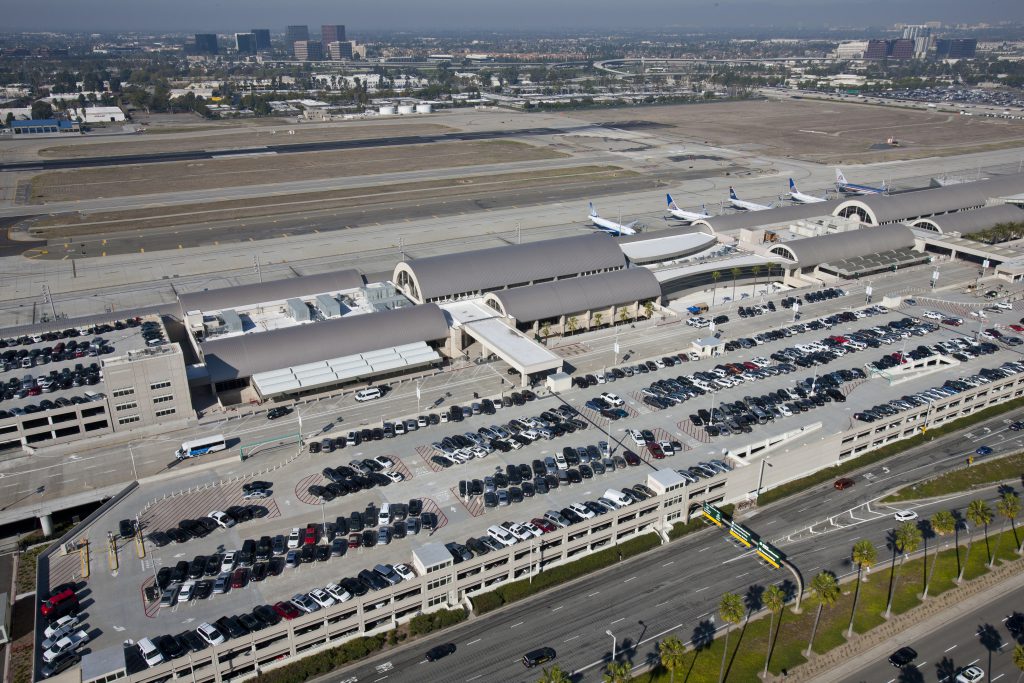
— Photo courtesy JWA/Matt Fukushima
About 125 residents packed into the community room at Newport Beach Civic Center this week to hear an update on an often-contentious topic: John Wayne Airport.
Community organization Speak Up Newport held their monthly meeting Wednesday, titled “What is the Future of the John Wayne Airport General Aviation Improvement Program (GAIP)?”
Speakers included: Tom Edwards, the city’s aviation consultant; Susan Dvorak, from community group Citizens Against Airport Noise & Pollution; and Joe Daichendt, from ACI, one of the county’s current General Aviation services providers.
The large crowd often applauded, most often during Dvorak’s comments, and sometimes vocally or visually disagreed with other points.
A key issue Dvorak pointed out is that they don’t know any of the project details and, “in spite of this,” the OC supervisors voted in favor of it. This is not a “win” for the residents of Newport Beach, she said.
At the end of the day, nobody knows exactly what will be included in this project or how many jet operations will be included, Dvorak said. It’s up to the residents to work to solve it and push for it, she concluded, eliciting a partial standing ovation from the audience.
“We believe the community must have representation, participation, input and oversight at all phases of the bidding process,” noted Dvorak.
The GAIP was “dropped on us,” Councilman Jeff Herdman said during his introduction of the speakers.
Herdman, chair of the city’s Aviation Committee, said the implementation of the Federal Aviation Administration’s NextGen, or Next Generation Air Transportation System, and its impact on the city has been their focus for the past few years. NextGen is a modernization program being implemented at airports across the country. It incorporates less fanning and more narrowing of the flight paths, which has had some negative impacts on Newport Beach.
They have been working on the issue, notably talking directly with the air carriers who have voluntarily agreed to work with the city in studying quieter takeoff procedures from JWA. The discussions are ongoing, he added. This effort will continue, Herdman noted.
Then came the GAIP, which “completely changed our focus,” Herdman said.
“Our attention was taken away from commercial aviation and focused on general aviation practices and procedures out of John Wayne Airport,” he said.
Orange County Board of Supervisors voted 5-0 on June 25 for an alternative plan, which includes many elements of the project alternative supported by the city of Newport Beach.
Proposed by Supervisor Michelle Steel, whose district covers Newport Beach, the plan is meant to be a “compromise” with a mix of general aviation at the local airport.
The proposed project calls for two full-service and one new and one existing limited-service Fixed Base Operators.
Plans also include allowing an international general aviation facility with hours limited between 5 a.m. and midnight.
The hours of operation were an issue that Dvorak, and much of the audience, had concerns about.
It also limits medium and large general aviation jet aircraft to 25.6 acres on JWA property and designates 35.6 acres exclusively for small general aviation aircraft.
It preserves space at the airport for small GA planes by “imposing land use and lease restrictions on certain airport parcels so that more than 50 percent of the airport area available for general aviation will be dedicated to light general aviation aircraft. In doing so, the plan will help to preserve the presence of small general aviation (twin- and single-engine) aircraft, and thereby limit the amount of space for general aviation jets, at the airport,” city officials explained.
Daichendt admitted that there is a lot of frustration in the community regarding the airport. He didn’t understand the noise impact fully until about six months ago, he added. It’s unnecessarily increased since NextGen, Daichendt said. A lot of it has to do with flight paths, he explained, and suggested a voluntary noise abatement program.
The city does not have the ability to control the airport outside of the JWA settlement agreement, Edwards noted.
“This is essentially an update of the facilities,” Edwards concluded, similar to a homeowner remodeling their house, he added.
There are no changes or expansion to the physical size of the airport, Edwards confirmed.
Currently, there are two fixed based operators on the east side of the airport and hangar space for one of the FBOs on the northwest side, Edwards explained.
“This program that’s being presented does not introduce fixed base operators,” Edwards said. “They’ve been there, they’ve been in existence for a number of years.”
An issue of concern, however, is the size and number of those particular FBOs. Another is the proposed general aviation terminal.
Residents in the crowd also raised some concerns with the proposed General Aviation Facility for international traveler screening. That would allow a “port of entry” for planes coming in from overseas, Edwards explained.
Everything else proposed is already at the airport in one form or another, apart from the GAF, he added.
The option for GA terminal with a General Aviation Facility with limited hours may or may not be adopted, Edwards noted. It’s up to each FBO when they respond to the request for proposals whether or not they include it in their proposal.
The “port of entry” designation is unnecessary, creates security issues, and establishes more lenient hours of operation, setting a bad precedent for the future.
This is still on the drawing board, Edwards emphasized.
“This is literally the beginning,” Edwards said. “If you’re a marathon runner this is like you’re at mile one.”
In the next six months or so the county will put out a request for proposals. Fixed Based Operators will respond to the RFP over a six- to nine-month process. After reviewing the proposals, the county will select one to pursue.
Dvorak listed several stipulations they would like to see during the RFP process: Maintain the mix of jets and small planes from 2016; limit hangar width to 40 feet or less; stipulate that the FBO hours of operation will conform to commercial aviation’s hours of operation (applause); stipulate that the FBO lease terms adhere to commercial hours of operation , including strict termination of the lease for repeated violations; remove the GAF international terminal from the project, including port of entry designation; establish that JWA general aviation aircraft depart in a northerly direction whenever safely possible; and ensure that Jet Suite X customers are processed through the main terminal.
“If the supervisors’ intent is to protect residents they should have no problem including these stipulations in writing in the RFP bidding process,” Dvorak said.
The project will likely be built in 14 phases over the next seven or more years, Edwards noted.
For more information on the meeting, call (949) 224-2266 or visit speakupnewport.com
For more information about the GAIP, visit newportbeachca.gov/government/departments/city-manager/john-wayne-airport/jwa-general-aviation-improvement-program




